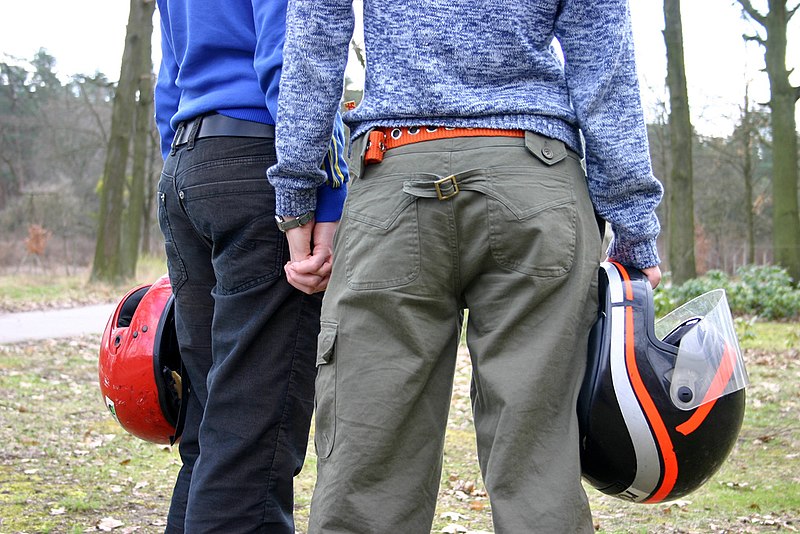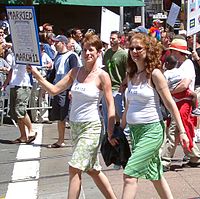pic: rt69 on flickr.com (Queereaster)
Lesbian is a term most widely used in the English language to describe sexual and romantic desire between females. The word may be used as a noun, to refer to women who identify themselves or who are characterized by others as having the primary attribute of female homosexuality,, or as an adjective, to describe characteristics of an object or activity related to female same-sex desire.
Lesbian as a concept, used to differentiate women with a shared sexual orientation, is a 20th-century construct. Although female homosexuality has appeared in many cultures throughout time, not until recently has lesbian described a group of people. In the late 19th century, sexologists published their observations on same-sex desire and behavior, and designated lesbians in Western culture as a distinct entity. As a result, women who became aware of their new medical status formed underground subcultures in Europe and North America. Further broadening of the term occurred in the 1970s with the influence of second wave feminism. Historians since have re-examined relationships between women in history, and have questioned what qualifies a woman or a relationship as lesbian. The result of such discussion has introduced three components to identifying lesbians: sexual behavior, sexual desire, or sexual identity.
Men have historically shaped ideas about what is respectable for women in love, sex, and family, and, because of the absence of males in a lesbian relationship, frequently rejected the possibility of lesbianism or disregarded it as a valid expression of sexuality. Early sexologists based their characterization of lesbians on their beliefs that women who challenged their strictly prescribed gender roles were mentally ill. Since then, many lesbians have often reacted to their designation as immoral outcasts by constructing a subculture based on gender role rebellion. Lesbianism has sometimes been in vogue throughout history, which affects how lesbians are viewed by others as well as how they view themselves. Some women who engage in homosexual behavior may reject the lesbian identity entirely, refusing to identify themselves as lesbian or bisexual.
The different ways lesbians have been portrayed in the media suggests that Western society at large has been simultaneously intrigued and threatened by women who challenge feminine gender roles, and fascinated and appalled with women who are romantically involved with other women. Women who adopt the lesbian identity, however, share experiences that form an outlook similar to ethnic identity: as homosexuals, they are unified by the discrimination and potential rejection they face from their families, friends, and others. As women, they face concerns separate from men. Lesbians may encounter distinct health concerns. Political conditions and social attitudes also continue to affect the formation of lesbian relationships and families.
Sexuality and lesbians
The presence of sexual activity between women as necessary to define a lesbian or a relationship continues to be debated. According to feminist writer Naomi McCormick, women's sexuality is constructed by men, whose primary indicator of lesbian sexual orientation is sexual experience with other women. The same indicator is not necessary to identify a woman as heterosexual, however. McCormick states that emotional, mental, and ideological connections between women are as important or more so than the genital. Nonetheless, in the 1980s, a significant movement rejected the desexualization of lesbianism by cultural feminists, causing a heated controversy called the Sex Wars. Butch and femme roles returned, although not as strictly followed as they were in the 1950s. They became a mode of chosen sexual self-expression for some women in the 1990s. Once again, women felt safer claiming to be more sexually adventurous, and sexual flexibility became more accepted.
The focus of this debate often centers on a phenomenon named by sexologist Pepper Schwartz in 1983. Schwartz found that long-term lesbian couples report having less sexual contact than heterosexual or homosexual male couples, calling this lesbian bed death. However, lesbians dispute the study's definition of sexual contact, and introduced other factors such as deeper connections existing between women that make frequent sexual relations redundant, greater sexual fluidity in women causing them to move from heterosexual to bisexual to lesbian numerous times through their lives—or reject the labels entirely. Further arguments attested that the study was flawed and misrepresented accurate sexual contact between women, or sexual contact between women has increased since 1983 as many lesbians find themselves freer to sexually express themselves.
More discussion on gender and sexual orientation identity has affected how many women label or view themselves. Most people in western culture are taught that heterosexuality is an innate quality in all people. When a woman realizes her romantic and sexual attraction to another woman, it may cause an "existential crisis"; many who go through this adopt the identity of a lesbian, challenging what society has offered in stereotypes about homosexuals, to learn how to function within a homosexual subculture. Lesbians in Western cultures generally share an identity that parallels those built on ethnicity; they have a shared history and subculture, and similar experiences with discrimination which has caused many lesbians to reject heterosexual principles. This identity is unique from gay men and heterosexual women, and often creates tension with bisexual women. Social theorists note that often behavior and identity do not match: women may label themselves heterosexual but have sexual relations with women, self-identified lesbians may have sex with men, or women may find that what they considered an immutable sexual identity has changed over time. A 2001 article on differentiating lesbians for medical studies and health research suggested identifying lesbians using the three characteristics of identity only, sexual behavior only, or both combined. The article declined to include desire or attraction as it rarely has bearing on measurable health or psychosocial issues.
source : http://en.wikipedia.org








